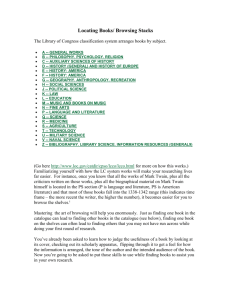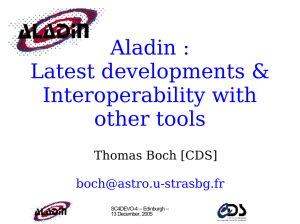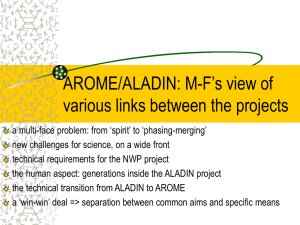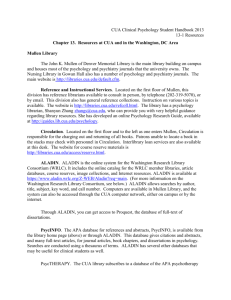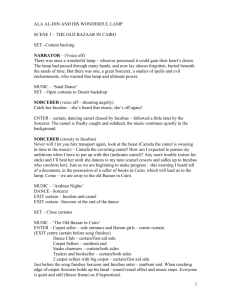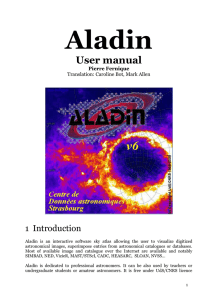Syllabus -- Marketing Libraries and Information Services
advertisement
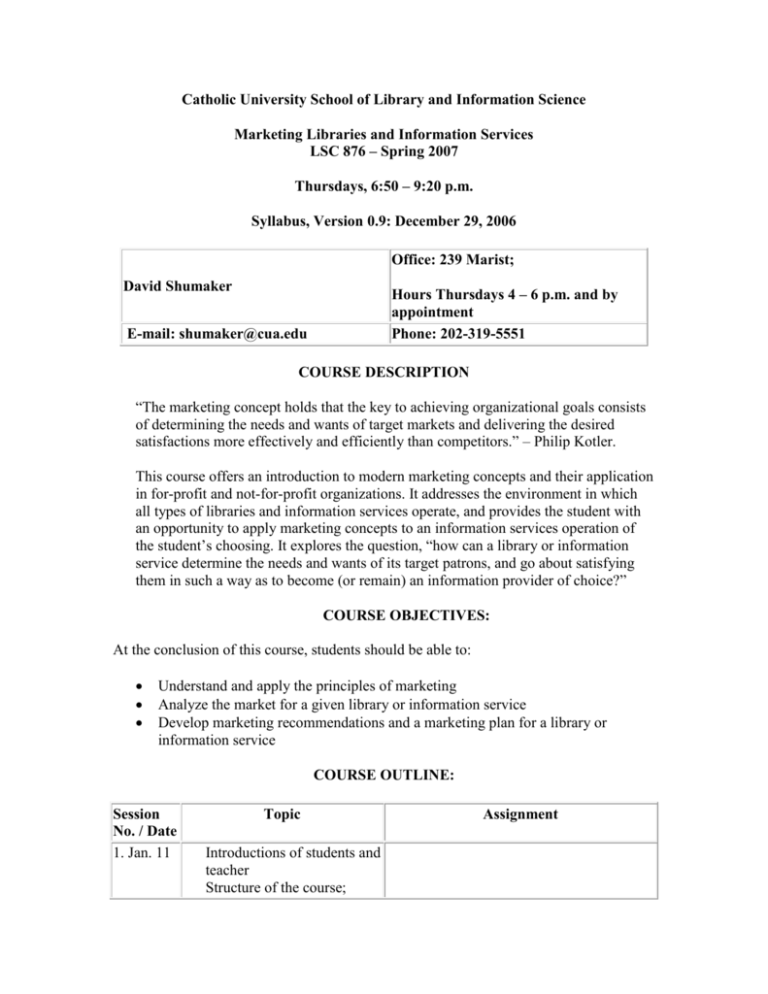
Catholic University School of Library and Information Science Marketing Libraries and Information Services LSC 876 – Spring 2007 Thursdays, 6:50 – 9:20 p.m. Syllabus, Version 0.9: December 29, 2006 Office: 239 Marist; David Shumaker Hours Thursdays 4 – 6 p.m. and by appointment Phone: 202-319-5551 E-mail: shumaker@cua.edu COURSE DESCRIPTION “The marketing concept holds that the key to achieving organizational goals consists of determining the needs and wants of target markets and delivering the desired satisfactions more effectively and efficiently than competitors.” – Philip Kotler. This course offers an introduction to modern marketing concepts and their application in for-profit and not-for-profit organizations. It addresses the environment in which all types of libraries and information services operate, and provides the student with an opportunity to apply marketing concepts to an information services operation of the student’s choosing. It explores the question, “how can a library or information service determine the needs and wants of its target patrons, and go about satisfying them in such a way as to become (or remain) an information provider of choice?” COURSE OBJECTIVES: At the conclusion of this course, students should be able to: Understand and apply the principles of marketing Analyze the market for a given library or information service Develop marketing recommendations and a marketing plan for a library or information service COURSE OUTLINE: Session No. / Date 1. Jan. 11 Topic Introductions of students and teacher Structure of the course; Assignment 2. Jan. 18 3. Jan. 25 4. Feb. 1 5. Feb. 8 6. Feb. 15 7. Feb. 22 Mar. 1 8. Mar. 8 9. Mar. 15 10. Mar. 22 11. Mar. 29 Apr. 5 12. Apr. 12 13. Apr. 19 14. Apr. 26 course requirements Overview of marketing Strategic Planning; SWOT; Customer Research; The 6 P’s Online Class -- Students finalize field work plans. Marketing Plans and Implementation; New Directions in Marketing Strategy, Planning and Market Research Workshop: Customer surveys Online Class – Time for Field Work Product Lifecycle and Positioning Workshop: Goal setting No Class – Spring Break Online Class – Time for Field Work Midterm Project Reports Branding, Promotion and eMarketing Workshop: Marketing communication Online Class – Time for Field Work No Class – Easter Recess Evaluation of Marketing Workshop: Evaluation and Re-positioning Term Project Presentations Term Project Presentations Read: Walters, Chapters 1-4 Online Discussion: The Library Brand Read: “Perceptions of Libraries”, Part 3 Read: Walters, Chapters 5-7 Field work plans due. Read: Andreasen; Breen; Brown; Chmelik; Dimick; Gaddis; Henderson; Kotler 1979; Lee; Lifer; Selden & Colvin Online Discussion: Customer Orientation Read: Lustig; Lustig & Corcoran; Penniman Online Discussion: Positioning Midterm Project Reports Due. Read: Angus & Oppenheim; Barber & Wallace; Brunsdale; Claggett; Fichter; Olson; Osif; Peppriell; Schrock; Yun Online Discussion: eMarketing Read: Brewerton; Keiser & Stein; Kotler 1977; Kumaravel; Kyrillidou; Snoj & Petermanuc May 3 Course Wrapup Final Exam Term Project Reports Due REQUIRED TEXTS Walters, Suzanne. (2004) Library Marketing That Works! New York: Neal-Schuman. ISBN: 1-55570-473-5. ADDITIONAL REQUIRED READINGS Note: Additional optional readings are found in the course Blackboard site. Andreason, A. R. (1982). "Nonprofits: Check Your Attention to customers." Harvard Business Review 60(3): 6. Angus, E. and C. Oppenheim (2004). "Studies of the Characteristics of Brand Names Used in the Marketing of Information Products and Services II: Internet Related Services." Aslib Proceedings 56(1): 12. Available: ALADIN – Emerald. Barber, P. and L. Wallace (2005). Building a Marketing Communication Plan. PLA 2005 Spring Symposium, Library Communications Strategies. Available: http://www.ala.org/ala/pla/plaevents/plaspringsymp/springsympprog/marketingha ndout.pdf Breen, B. (2006, Aug 2006). "To Read the Consumer's Mind." Fast Company Retrieved 01 November 2006, 2006, from http://www.fastcompany.com/design/2006/design-consumer.html. Brewerton, A. (2003). "Inspired! Award-winning library marketing." New Library World 104(7/8): 267. Available: ALADIN – Emerald. Brown, S. A. (1997). "Marketing the corporate information center for success." Online 21(4): 74. Available: ALADIN – Ebscohost, Proquest ABI-Inform, Wilson Library Literature. Brunsdale, M. (2000). "From Mild to Wild: Strategies for Promoting Avademic Libraries to Undergraduates." Reference & User Services Quarterly 39(4): 5. Available: ALADIN – Proquest. Chmelik, S. (2006). "Market Research for Libraries." Information Outlook 10(2): 23. Available: ALADIN – Proquest. Claggett, L. (2002). "Identify Your Brand, Before You Market." Information Outlook 6(11): 12. Available: ALADIN – Proquest. Dimick, B. (1995). "Marketing youth services." Library Trends 43(3): 463. Fichter, D. (2003) "Why and How to Use Blogs to Promote Your Library's Services." Marketing Library Services Volume, DOI: Gaddis, S. (1998). How To Design Online Surveys. Training & Development: 5. Henderson, K. (2005). "Marketing Strategies for Digital Library Services." Library Review 54(5/6): 4. Available: ALADIN: Emerald. Keiser, B. and P. Stein (2006). Conducting a Comprehensive Communications Audit. SLA 2006 Annual Conference. Baltimore, MD, SLA. Kotler, P. (1977). "The Marketing Audit Comes of Age." Sloan Management Review 18(2): 19. Kotler, P. (1979). "Strategies for Introducing Marketing into Nonprofit Organizations." Journal of Marketing 43(1): 8. Kumaravel, J. P. S. (2005). University Librarians: Changing Role. SLA 2005 Annual Conference. Toronto, Ontario, SLA. Kyrillidou, M. "An Overview of Performance Measures in Higher Education and Libraries. ." ARL: A Bimonthly Journal of Research Library Issues and Actions(Issue 197). Lee, D. (2004). "Market Research: Market Segmentation and Libraries." Library Administration & Management 18(1): 47. Lifer, E. S. (2001). "Tapping into the zen of marketing." Library Journal 126(8): 44. Lustig, J. (2006). TrendAlert: It’s Web 2.0 — Do You Know Where Your Library Is?, Outsell Inc. Lustig, J. and M. Corcoran (2005). Information Management Best Practices: Next-Gen IM – Moving Beyond The Repository, Outsell, Inc. Olson, C. A. (2002). "What's in it for Them? Communicating the Value of Information Services." Information Outlook 6(11): 18. Osif, B. A. (2006). "Branding, Marketing, and Fund-raising." Library Administration & Management 20(1): 39. Penniman, W. D. (1997). "Strategic positioning of information services in a competitive environment " Bulletin of the American Society for Information Science 23(4): 4. Available: ALADIN – Periodical Abstracts. Peppriell, B. J. (1998). "Web Site planning 101: Essential steps for developing your Web Site from a marketing perspective." Searcher 6(8): 19. Perceptions of Libraries and Information Resources. (2005) Dublin, OH: OCLC Computer Library Center. ISBN: 1-55653-364-0. Available online at: http://www.oclc.org/reports/2005perceptions.htm , or order at https://www.oclc.org/webapp/wcs/stores/servlet/ProductDisplayView?storeId=10051 &catalogId=10051&langId=-1&parent_category_rn=10301&productId=12001 ($19.00) Schrock, K. (2003). "The ABC's of marketing." School Library Journal 49(11): 36. Seldon, L. and G. Colvin (2003). What Customers Want. Fortune: 3. Snoj, B. and Z. Petermanuc (2001). "Let Users Judge the Quality of Faculty Library Services." New Library World 102(9): 11. Yun, S. (2004). "Branding Helped to Promote Our Library and Its Technology." Computers in Libraries 24(5): 18. Available: ALADIN. COURSE REQUIREMENTS AND GRADING: Successful completion of this course entails on-time delivery of assignments, work that meets or exceeds the standard for graduate-level programs, and regular, active participation in class discussions, exercises, and activities. Students should have access to word processing and presentation software, email, and the World Wide Web. Assignments are due before class on the date indicated. Unless prior permission is obtained, the grade for late assignments will be reduced by 2 points (out of 100) per day; however, any work not turned in on or before May 3 will receive a zero grade. Grades are based on work submitted; rewriting, resubmission, and extra credit are not allowed. Assignments and their weighting in the overall course grade are: 1. Field Work Plan (10%) Using a template provided by the instructor, each student will complete a written plan for the course’s field work component. Plans will be evaluated for clarity, completeness, and expressed relationship to the goals of the course. 2. Midterm Report (20%) Students will submit a written report on project status as of early March, with an updated project plan. Each student will also give a 10-minute oral presentation in class. The grade will be for the combined oral and written products, and will be assigned based on clarity, challenge of the field work project, and expressed relationship to the goals of the course. 3. Final Report (40%) Each student will prepare a final written report on the field work project. The report will evaluate accomplishments in relation to the project plan, provide a narrative account of the project work, and reflect on what the student learned from the project. Deliverables produced in the project may be included if appropriate and if the host permits. In addition to the written report, each student will present a 20 minute oral report to the class. 4. Final Exam (20%) There will be an in-class final exam. 5. Class Participation (10%) Several weeks during the term, the class will not meet in person. The primary reason for this is to give students time to work on their term projects. During these weeks, there will be a theme and some assigned light reading. Students are expected to contribute to an online discussion about the theme and the reading. GRADING SUMMARY: Assignments Field Work Plan Midterm Report Final Report Final Exam Class Participation Weight 10% 20% 40% 20% 10% Total 100% Based on scores for individual assignments, final grades will be assigned as follows: > 92 91-92 89-90 82-88 80-81 70-79 <70 A AB+ B BC F WRITING AND PRESENTATION STANDARDS: Effective information professionals are also effective communicators. Written and oral communication are important elements of the total communication process. To this end, all papers and presentations must demonstrate graduate level clarity and effectiveness of expression. Careful attention should be given to source citations, proper listing of references, the use of footnotes, and the presentation of tables and graphs. All papers will be typed, double-spaced, using a standard typeface. ADDITIONAL POLICY STATEMENTS ACADEMIC HONESTY: You will find Academic Affairs policies on “Academic Dishonesty” and on "Unethical Practices" in the University Policies and Procedures web page at http://policies.cua.edu/academicundergrad//integrityfull.cfm . You are held responsible for adhering to these policies. Incidences of academic dishonesty, defined by the University as “failure to observe rules of fairness in taking exams or writing papers, plagiarism, fabrication, and cheating” will result in a grade of F (0 points) on the project or exam in question, and will be reported to the Dean for possible further action (including failure in the course). Talk with your instructor if you have questions about what is involved in such offenses. Plagiarism, which includes "[1] intentionally or knowingly representing the words or ideas of another as one's own in any academic exercise; [2] failure to attribute any of the following: quotations, paraphrases, or borrowed information from print sources or websites; [3] buying completed papers from other to use as one's own work", will not be tolerated. For more on what constitutes plagiarism and how to avoid it, see the guide on the Purdue Online Writing Lab web site at http://owl.english.purdue.edu/handouts/research/r_plagiar.html ADA ACCOMMODATION: Students with disabilities requiring accomodation under federal regulations must present a written accommodation request to the instructor by the second class meeting . It is strongly recommended that the student contact the Office of Disability Support Services , Suite 207, Pryzbyla Center (202-319-5211; email cuadisabilityservices@cua.edu, web http://disabilitysupport.cua.edu/). This is the University office responsible for disability accommodation and services, and its staff can answer questions about services and requirements regarding documentation. Special accomodations or other arrangements cannot be made without documentation approved by this office.


